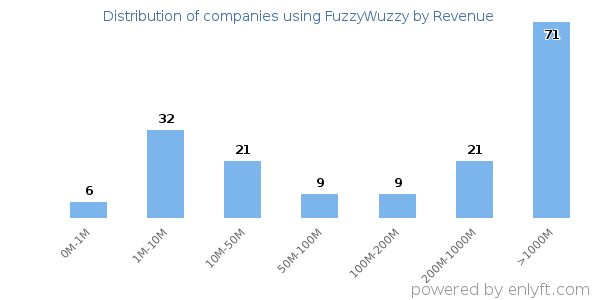Companies using FuzzyWuzzy
We have data on 163 companies that use FuzzyWuzzy. The companies using FuzzyWuzzy are most often found in United States and in the Information Technology and Services industry. FuzzyWuzzy is most often used by companies with >10000 employees and >1000M dollars in revenue. Our data for FuzzyWuzzy usage goes back as far as 7 years and 5 months.
If you’re interested in the companies that use FuzzyWuzzy, you may want to check out Google Translate API and MXNet as well.
Who uses FuzzyWuzzy?
| Company | Accenture PLC |
| Website | accenture.com |
| Country | Ireland |
| Revenue | >1000M |
| Company Size | >10000 |
| Company | Cognizant Technology Solutions Corp |
| Website | cognizant.com |
| Country | United States |
| Revenue | >1000M |
| Company Size | >10000 |
| Company | Infosys Ltd |
| Website | infosys.com |
| Country | India |
| Revenue | >1000M |
| Company Size | >10000 |
| Company | International Business Machines Corporation |
| Website | ibm.com |
| Country | United States |
| Revenue | >1000M |
| Company Size | >10000 |
| Company | Wipro Ltd |
| Website | wipro.com |
| Country | India |
| Revenue | >1000M |
| Company Size | >10000 |
| Company | Website | Country | Revenue | Company Size |
|---|---|---|---|---|
| Accenture PLC | accenture.com | Ireland | >1000M | >10000 |
| Cognizant Technology Solutions Corp | cognizant.com | United States | >1000M | >10000 |
| Infosys Ltd | infosys.com | India | >1000M | >10000 |
| International Business Machines Corporation | ibm.com | United States | >1000M | >10000 |
| Wipro Ltd | wipro.com | India | >1000M | >10000 |
Target FuzzyWuzzy customers to accomplish your sales and marketing goals.
FuzzyWuzzy Market Share and Competitors in Deep Learning
We use the best indexing techniques combined with advanced data science to monitor the market share of over 15,000 technology products, including Deep Learning. By scanning billions of public documents, we are able to collect deep insights on every company, with over 100 data fields per company at an average. In the Deep Learning category, FuzzyWuzzy has a market share of about 0.1%. Other major and competing products in this category include:
Deep Learning
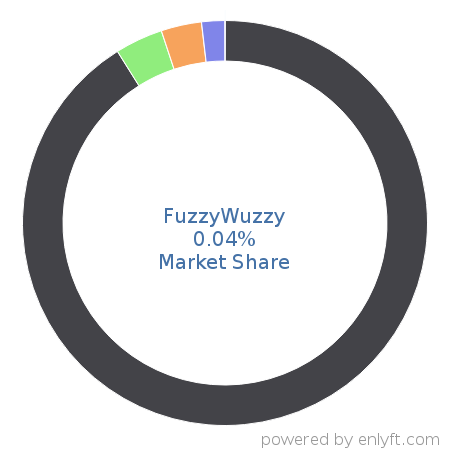

What is FuzzyWuzzy?
FuzzyWuzzy is a Fuzzy String Matching in Python that uses Levenshtein Distance to calculate the differences between sequences.
Top Industries that use FuzzyWuzzy
Looking at FuzzyWuzzy customers by industry, we find that Information Technology and Services (19%), Computer Software (11%), Higher Education (11%) and Financial Services (8%) are the largest segments.
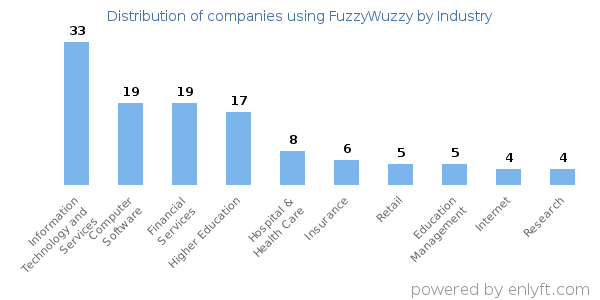
Top Countries that use FuzzyWuzzy
59% of FuzzyWuzzy customers are in United States, 9% are in India and 6% are in Canada.
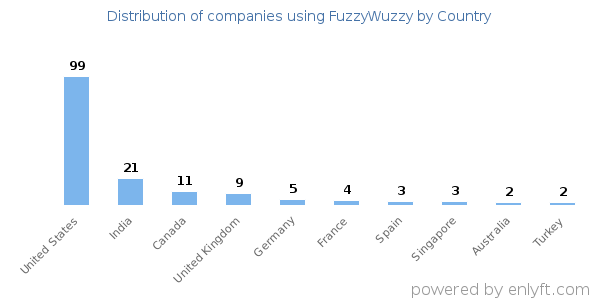
Distribution of companies that use FuzzyWuzzy based on company size (Employees)
Of all the customers that are using FuzzyWuzzy, a majority (50%) are large (>1000 employees), 14% are small (<50 employees) and 31% are medium-sized.
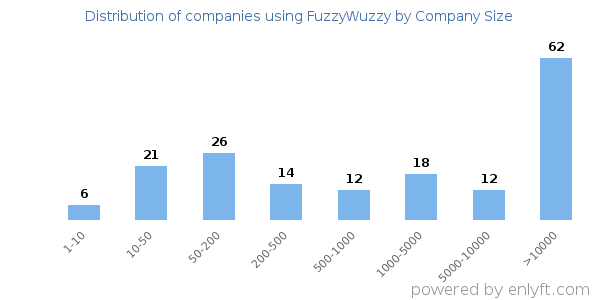
Distribution of companies that use FuzzyWuzzy based on company size (Revenue)
Of all the customers that are using FuzzyWuzzy, a majority (52%) are large (>$1000M), 28% are small (<$50M) and 12% are medium-sized.
